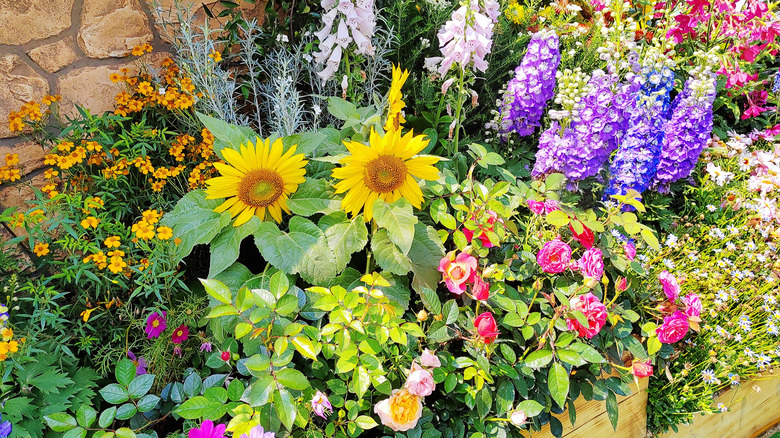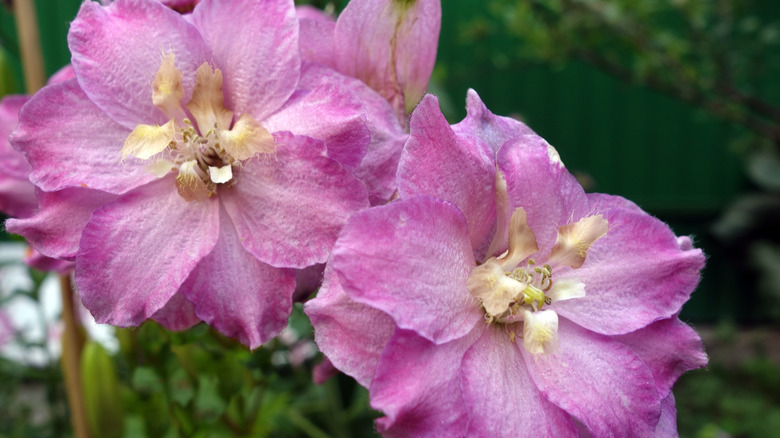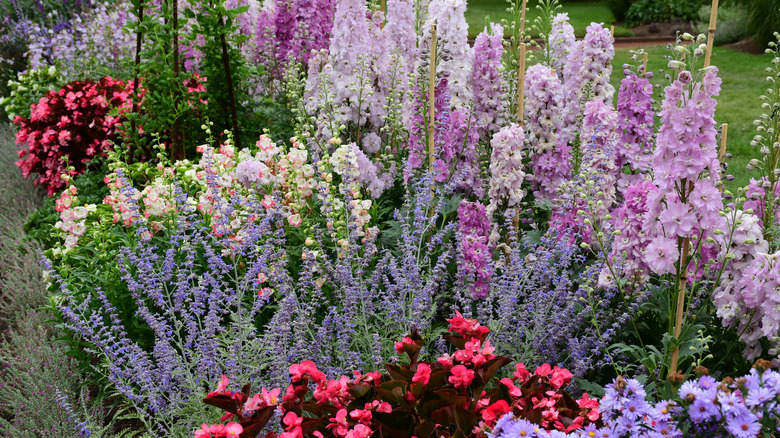The Stunning Flower You Should Plant For Colorful Blooms Multiple Times A Year
Anyone who is drawn to the romantic charm of an English cottage garden likely has delphinium (Delphinium elatum) on their radar (or planted in their borders already). These tall, elegant flower spikes are favorites for their soft, dreamy hues that come in shades like soft pinks, powder blues, gentle lavenders, and crisp whites. But if you're looking for a plant that offers height and beauty and is a perennial that blooms more than once per year, the delphinium 'Sweethearts,' part of the New Millennium series, may be exactly what you've been searching for.
After putting on its first show in early summer, delphinium 'Sweethearts' returns for an encore and blooms again later in the season — all that's needed is a simple mid-season trim. That second wave arrives just in time to revive an end-of-season garden, when most spring flowers have faded and the fall blooms haven't quite arrived. It's the kind of low-maintenance, high-reward plant every gardener dreams of.
How to grow New Millennium delphiniums successfully
Thanks to its impressive height (it can grow up to 5 feet tall), delphinium 'Sweethearts' makes a big impact no matter the size of your green space. It's the kind of flower that looks just as good framing your fence along your garden borders as it does lining a garden path. It's also a flower that you can winter-sow to get a head start on your spring garden, and while it may be well-suited to the cooler climates of USDA Hardiness Zones 3 through 7, it thrives in full sun.
The New Millennium delphinium 'Sweethearts' should be planted in nutrient-rich and well-draining soil, protected from strong winds and rain, watered consistently, and pruned in midsummer after the first batch of blooms has faded. These small efforts pay off, rewarding you with a second vibrant bloom as you enjoy the last of the year's long, warm evenings.
Unlike traditional delphiniums, which often require staking to prevent their flower spikes from flopping over, delphinium 'Sweethearts' have sturdier, stronger stems. This means fewer droops and much less maintenance. However, like all delphiniums, the 'Sweethearts' variety is toxic if ingested and can irritate the skin, which is why you should wear gloves when pruning or handling the plant and always wash your hands afterward. When deciding where to plant these tall beauties, opt for a space away from pets and children.
Incorporating delphinium 'Sweethearts' into your garden design
Whether you want to add to your established cottage garden, bring a more romantic feel to your planting scheme, or simply introduce some vertical interest to your borders and flowerbeds, the New Millennium delphinium 'Sweethearts' should be at the top of your list. Its pastel palette pairs effortlessly with quintessential cottage favorites, like foxgloves (Digitalis purpurea), peonies (Paeonia spp.), and heirloom roses (Rosa spp.), creating a soft, romantic look. Or for a meadow-style aesthetic, try mixing it with native grasses or wildflowers, as these pared-back plants allow the delphiniums to truly shine.
The sheer height of delphinium 'Sweethearts' can add instant structure to any garden, whether it is planted in rows to line a garden path, or together in pockets to create a more relaxed look. To make the most of the delphinium's towering blooms, pair it with low-growing companions in soft, complementary tones, like pale blue salvia (Salvia nemorosa), peachy daylilies (Hemerocallis spp.), or fragrant lavender (Lavandula spp.). The result? A dynamic, layered border with depth, and a whole lot of charm.
Because delphinium 'Sweethearts' blooms more than once, it'll frame your summer with color. It offers a stunning show both early and late in the season, making it a rewarding choice that brings beauty to your garden for longer.


